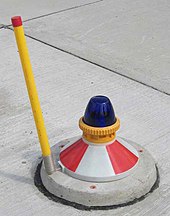Runway
With runway (including taxiway , English taxiway . See taxiing , roll '; short TWY ) are in the aviation routes between runways (Engl. Runway and) ahead of an airfield designated. Together with the runways, the taxiways form the runway ( English maneuvering area ).
Features of the taxiways

Paved runways are usually, but not always, indicated by yellow lines. The center of paved taxiways is marked by a solid yellow line, the edges by a double yellow line (see also marking of taxiways and taxiways ).

The taxiways have an alphanumeric identification. Usually they are only designated with letters, but sometimes - especially on large airfields with numerous taxiways - taxiways also have combinations of letters and numbers. The signs along the taxiways consist of yellow signs on a black background. At some airports the taxiways are also labeled with large letters painted on the runway. At smaller airfields there is often no marking of the taxiways at all, or there are no fixed taxiways at all, only a large meadow as a taxiway.
Differentiation to roller alleys
Compared to runways are rolling lanes (engl. Taxi lanes ) paths that are only for Zurollung to a parking position. Taxiways must have a greater safety distance to other objects than taxiways and therefore require more space. If the routes to parking positions were also classified as taxiways, the space requirement would be greater and the overall capacity of the airfield would be reduced. At an airport, taxiways are only used on the apron.
Lighting
In the dark or when visibility is poor, taxiways are marked with blue lights on both sides, unlike runways, which are illuminated in white. At most of the larger airfields, the intensity of the runway and taxiway lights can be changed at the pilot's request .
One differentiates:
- Twyl : runway lights ( English taxiway lights )
- TXE : blue rimfire ( English taxiway edge )
- TXC : green centerline light ( English taxiway centerline ).
Runway edge lights are round radiating lights in surface or underfloor construction. Taxiway centerline lights, on the other hand, are directional lights in an underground construction. Underfloor lights can be run over by aircraft. Taxiways that are in the area of the protection zones of the glideslope transmitter or landing course transmitter have coded taxiway center line lights (green / yellow). Basically, roll in such a way that the aircraft's nose wheel rolls exactly along this center line. This is the only way to ensure the necessary freedom from obstacles .
Safety measures
In order to move the aircraft on the taxiways of a controlled airfield, pilots need a clearance which must be requested beforehand (e.g. during taxiing control ). This approval is also necessary for all other vehicles (e.g. clearing vehicles and marshallers ).
On the heavily traveled airports allow rapid-exit taxiways and high-speed turnoffs (German: speed taxiways ), the runway to leave at a higher speed. This means that the runway is free again more quickly, which allows a higher graduation frequency.
To increase safety while an aircraft is taxiing, some airports (in the DFS area - as of 1999 - Hamburg , Hanover , Tegel , Schönefeld , Leipzig / Halle , Düsseldorf , Cologne / Bonn , Frankfurt , Nuremberg , Stuttgart , Munich ) have ground radar (SMR, Surface Movement Radar or ASDE, Airport Surface Detection Equipment ).
The same applies to taxiways as part of the flight operations areas that they must be kept free of snow in winter and also ice-free through de-icing .
Enhanced Taxiway Centerline
The (improved) Enhanced Taxiway Centerline is planned at 70 major US airports. For the last 150 feet (~ 46 m) in front of a runway holding position, in addition to the normal continuous taxiway centerline, a dashed line is recorded to the right and left of it.
literature
- Bachmann, Faber, Senftleben: Danger manual for pilots . Motorbuch Verlag, Stuttgart 1981, ISBN 3-87943-656-8 .
- Dieter Franzen: Compact learning program to prepare for the radio communication test . 6th edition. AZF, 1991.
- Jeppesen Sanderson: Private Pilot Manual . 2001, ISBN 0-88487-238-6 .
- Wolfgang Kühr: Air law . In: The private pilot . tape 5 , 1983, ISBN 3-921270-13-8 .





